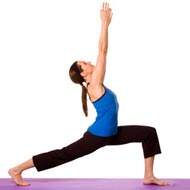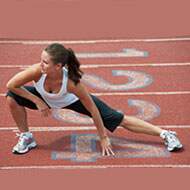- Arm Stretches
- Chest Stretches
- Shoulder Stretches
- Leg Stretches
- Knee Stretches
- Lower Back Stretches
- Hamstring Stretches
- Running Stretches
- Back Stretches
- Thigh Stretches
- Groin Stretches
- Neck Stretches
- Glute Stretches
- Hip Stretches
- Golfers Stretches
- Calf Muscles Stretches
- Ankle Stretches
- Iliotibial Band Stretches
- Piriformis Stretches
- Warm Up Stretches
- Soleus Stretch
- Gastrocnemius Stretch
- Lumbar Stretches
- Quadricep Stretches
- Ballistic Stretching
- Adductor Stretch
- Bicep Stretch
- Triceps Stretch
- Spine Stretches
- Upper Back Stretches
- Abdominal Stretches
- Types of Stretching
Dynamic Warm Up Stretches
As we go about our normal daily routine, we actually stretch our muscles with every movement. But as the movements become natural to us, the muscles get used to the range of motion and it barely feels like exercise or stretching to us.
Now try and exaggerate each movement and see how you feel. For example, as you walk, take a longer stride and make your steps larger than they would normally be.
If you do this you will definitely feel a stretch in your thighs, hamstrings, and calves. If while walking you simultaneously swing your arms, alternating between right and left, your shoulders and arms should feel stretched as well. This is an example of stretching with movement or as it is called – dynamic stretching. Experts define dynamic stretches as stretches that incorporate momentum and motion to make full use of all muscle groups involved. This movement and motion of each pose could either require a precise range of motion or use momentum to engage the muscles. Arm circles and walking lunges are some examples of dynamic stretches.
Dynamic Stretches For Runners & Soccer
If you wake up feeling stiff or spend too much time at a desk job, dynamic stretches can accomplish a lot over a limited amount of time. It helps build muscle strength, loosens up the body and reduces stiffness. In terms of competitive sports such as soccer and running, coaches now swear by the benefits of incorporating dynamic stretches into their warm-up routines. In sports, dynamic stretches can actually simulate the movements required while actually performing the sport.
Dynamic stretches for soccer includes kicking stretches that mirror the body’s movements required when the players perform on field. It also serves to warm the muscles and joint and prepare the body for the challenges ahead in the game.
If you are a runner, you can stick to static, traditional stretches at the end of your run to cool down but for a real burst of energy and to prepare your body adequately for the run ahead of you, dynamic stretching can work wonders. Coaches and experts suggest you start with a warm up jog, add dynamic stretches and then follow it up with strides. This routine can fire the correct muscles and warm them up for optimum performance. Basically, you work out all the right muscles in the right way thus improving your running speed and quality.
As mentioned, arm circles, exaggerated kicks and walking lunges are all types of dynamic stretches. All dynamic stretching involves movement while you stretch but without any jerking or bouncing motions. As you work within your range of movement, you are pushing the limits of your flexibility and improving it as well.
Types Of Dynamic Stretches
Here are some dynamic stretches that you can try in order to stay fit. If you are a beginner or have never exercised before, do these only under the guidance and supervision of a trainer or expert.
Small lunges
This is generally one of the first exercises in a dynamic stretch routine. Place your hands on your head and keep your spine straight as you take small measured step ahead and let your back knee drop to 6 inches off the ground.
Calf Step Backs
Keeping your core engaged flex your calf muscles by placing your leg behind you. Do this stretch once with your leg behind you straight and the next time bent. Do not bounce.
High Knees
As you run forward, raise your knees up to the level of your waistline and move fast, alternating your feet rapidly.
Heel Flicks
As you run or walk briskly, flick your heels back up behind you high enough to touch your lower back area.
Hamstring Walks
Mark out a 10-meter mark and aim for that. Bend at the waist and place your fingers in front of you. Put one foot about 6 inches ahead of the other and tilt your body until you feel a stretch in your hamstrings. Hold for a few seconds and then switch to the other leg. Continue doing this and move ahead till you reach the 10-meter mark.
Sideways High Knees
As you walk raise your knees sideways up to your waist level in an outward L-shape. Alternate this exercise between both legs.
Back Stretch
Keep your back straight and bend forwards and backwards but in slow deliberate movements. Do not bend and bounce in any direction as this could cause injury to the body.
Chest Stretch
Raise your arms to shoulder level and swing them open at the elbows to stretch your chest muscles.
Shoulder Stretch
Swing your arms vertically in front of you either up and down or at a slight diagonal to the sides.
Hamstring Lunges
When you are in the position of a deep lunge, pull your heels upwards and back as you come out of it to stretch your hamstrings.
Neck Mobility
Tuck your chin low into your chest before raising it upwards. Stretch your left ear to your left shoulder and alternate to the right side. Rotate your chin slowly from one shoulder to another. Repeat each of these exercises 10 times.
Arm Swings
Keep your back straight and your feet hip distance apart. Swing your arms together upwards, then down and then backwards. You can later add variations such as side and front crossovers of the arms.
Side Bends
Keep your knees soft and your legs a little more than hip width apart. Bend at your waist slowly to each side feeling the stretch from fingers to toes. Try and bend as far as possible in a straight line to the side.
Dynamic Warm Up Stretches: Do's & Don'ts
There are some dynamic stretches dos and don’ts that will help you optimize your routine.
Do's:
- The best time to practice a dynamic stretching routine is before a work out or a match or an event and as close to the event or location as possible.
- You will also need a fair amount of space for the proper range of movement in dynamic stretches.
- Aim for repetitions. Make sure that your dynamic exercises are customized to suit your particular activity or sport.
- Ideally, a soccer players exercise warm up routine will be different from that of a runner or swimmer, as different muscles need to be warmed up and used.
- Ideally, these exercises should each be repeated between 6 to 10 times. If you are a beginner or not very fit, aim for a minimum of 5 repetitions at least.
- Some of these exercises can be difficult to do so it is better that you follow a trainer or an expert when beginning.
- For more information on dynamic stretches there are several how to videos available online that you can follow as well to check if your form is right.
- Start the routine slowly and gradually increase your reps until you feel comfortable with them.
Don'ts:
- The biggest don’t when it comes to dynamic stretching is not to rush through the movements.
- Take time to learn them properly and do not skip any intermediary steps or you risk injury.
Dynamic Warm Up Stretches Benefits
- Since they are a combination of both stretching and a warm up, you also save time with these short, intense bursts of energy.
- A lot of people in fact use dynamic stretches as a work out and not just a warm up routine.
- Since there is so much stretching of the muscles involved, the possibility of injury is greatly reduced.
- If you are used to a static stretching routine you know that the ultimate goal of static traditional stretches is to hold a pose at its end position.
- With dynamic stretches, you continuously push yourself to improve your flexibility and range of movement.
- The more you practice; you will see the improvement in your postures and exercises over the weeks.
- Dynamic warm up stretches benefits you physiologically as well by stimulating the neurological system.
- The muscles as a result of this stimulation start anticipating the movement required and exhibit a quicker response.
- This becomes very imperative for athletes, who rely on quick responses to move faster, jump higher, run for longer and kick better.
- Dynamic stretches also increase the heart rate and prepare the body for the heavy work to come in case you are playing a sport.
- Since the muscles are warm, the chances of injury are also reduced.
- Most experts suggest that you combine the two types of stretches for the best results. Dynamic stretches wake up muscles and prepare them for the more intensive work out to come.
- These exercises can make you stronger if done properly and provide a more specific way to warm up for a particular sport.
- Trainers and therapists can customize dynamic stretching warm up as per the athlete’s requirements so that the warm up mirrors the movements on field.
- Performance as result improves significantly with dynamic stretches.
Dynamic Warm Up Stretches Disadvantage:
- One disadvantage of dynamic stretches is that it does not achieve the same range of flexibility as traditional or ballistic stretches do.



